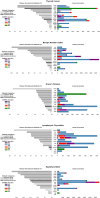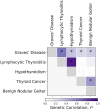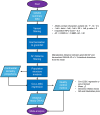This is a preprint.
Global multi-ancestry genetic study elucidates genes and biological pathways associated with thyroid cancer and benign thyroid diseases
- PMID: 40463558
- PMCID: PMC12132132
- DOI: 10.1101/2025.05.15.25327513
Global multi-ancestry genetic study elucidates genes and biological pathways associated with thyroid cancer and benign thyroid diseases
Abstract
Thyroid diseases are common and highly heritable. Under the Global Biobank Meta-analysis Initiative, we performed a meta-analysis of genome-wide association studies from 19 biobanks for five thyroid diseases: thyroid cancer, benign nodular goiter, Graves' disease, lymphocytic thyroiditis, and primary hypothyroidism. We analyzed genetic association data from ~2.9 million genomes and identified 235 known and 501 novel independent variants significantly linked to thyroid diseases. We discovered genetic correlations between thyroid cancer, benign nodular goiter, and autoimmune thyroid diseases (r 2 =0.21-0.97). Telomere maintenance genes contribute to benign and malignant thyroid nodular disease risk, whereas cell cycle, DNA repair, and DNA damage response genes are predominantly associated with thyroid cancer. We proposed a paradigm explaining genetic predisposition to benign and malignant thyroid nodules. We evaluated thyroid cancer polygenic risk scores (PRS) for clinical applications in thyroid cancer diagnosis. We found PRS associations with thyroid cancer risk features: multifocality, lymph node metastases, and extranodal extension.
Figures














Similar articles
-
The Role of Nuclear Medicine in the Clinical Management of Benign Thyroid Disorders, Part 2: Nodular Goiter, Hypothyroidism, and Subacute Thyroiditis.J Nucl Med. 2021 Jul 1;62(7):886-895. doi: 10.2967/jnumed.120.251504. Epub 2021 Feb 12. J Nucl Med. 2021. PMID: 33579801 Review.
-
Diagnostic performance of thyroid ultrasonography screening in pediatric patients with a hypothyroid, hyperthyroid or euthyroid goiter.Pediatr Radiol. 2016 Jan;46(1):104-11. doi: 10.1007/s00247-015-3435-4. Epub 2015 Aug 23. Pediatr Radiol. 2016. PMID: 26298554
-
DNA repair proteins may differentiate papillary thyroid cancer from chronic lymphocytic thyroiditis and nodular colloidal goiter.Sci Rep. 2021 May 11;11(1):9932. doi: 10.1038/s41598-021-89403-0. Sci Rep. 2021. PMID: 33976347 Free PMC article.
-
[Impact of serum thyroglobulin concentration in the diagnosis of benign and malignant thyroid diseases].Nuklearmedizin. 2000 Aug;39(5):133-8. Nuklearmedizin. 2000. PMID: 10984889 German.
-
Benign thyroid disease: what is the role of nuclear medicine?Semin Nucl Med. 2006 Jul;36(3):185-93. doi: 10.1053/j.semnuclmed.2006.03.006. Semin Nucl Med. 2006. PMID: 16762609 Review.
References
Publication types
Grants and funding
LinkOut - more resources
Full Text Sources
